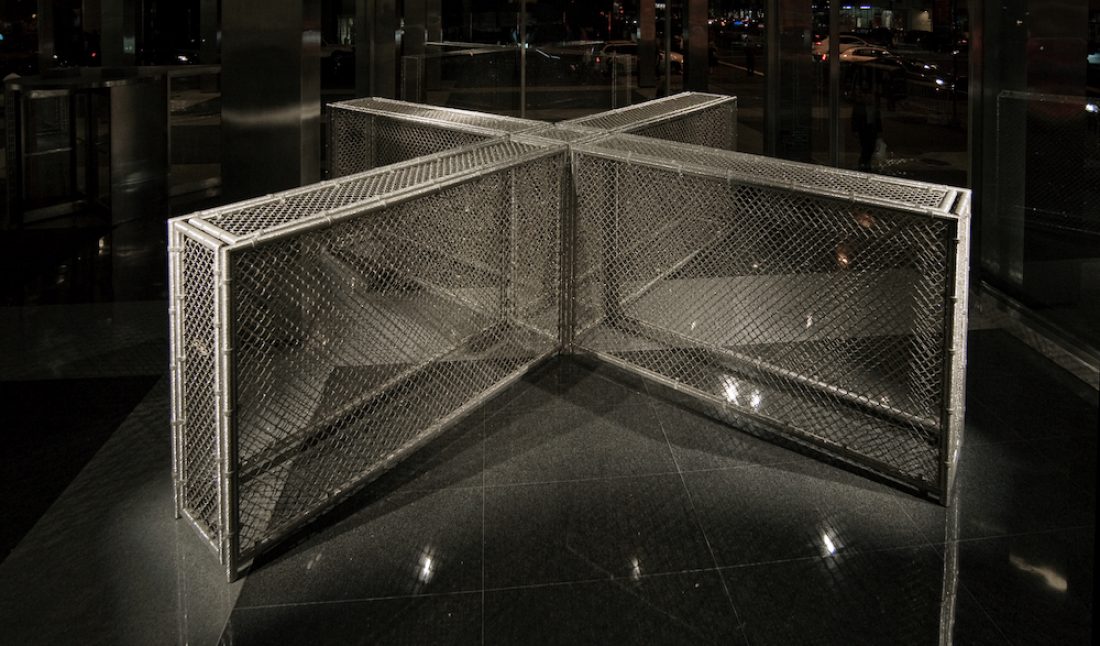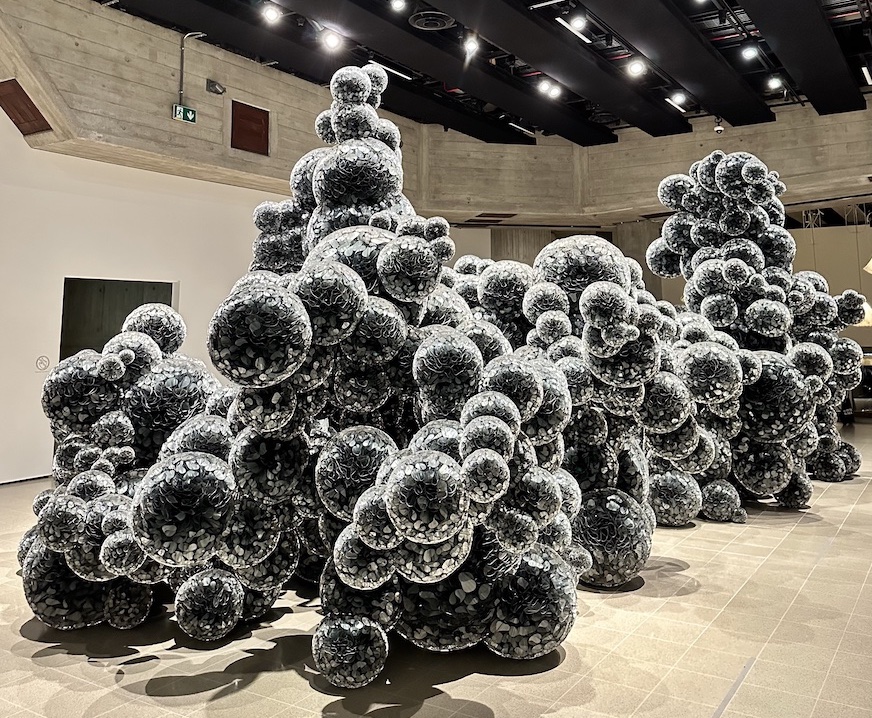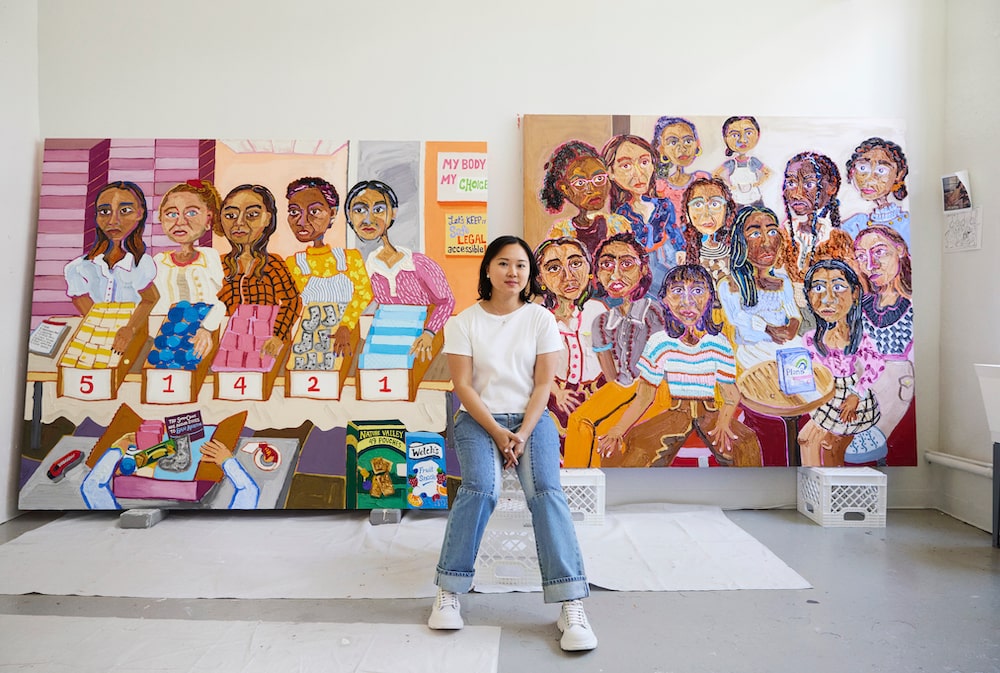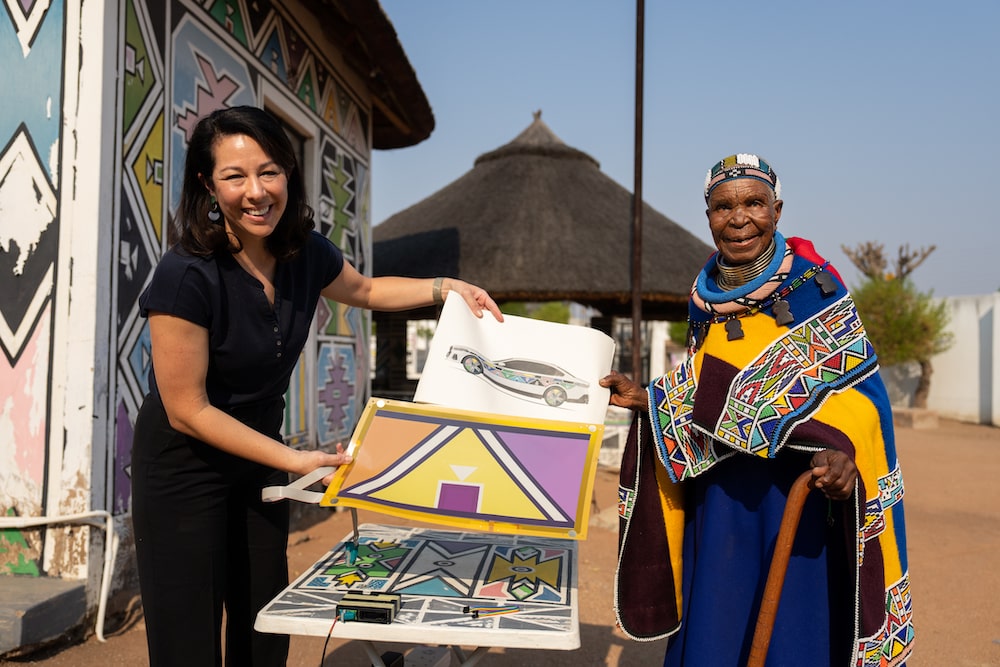In the early 1990s, Liza Lou re-imagined the American kitchen in tiny, beautiful beads. Her full-scale, painstaking work, appropriately-titled Kitchen, is a Technicolor dream—checkered tiles gleam like holograms, tentacles of glass gush from an encrusted spout, a familiar cherry pie sits on an oven rack, waiting to be consumed. Lou’s re-conceptualization of the central domain of domesticity serves as a monument to women’s overlooked labor, a confrontation of heteronormative feminine tropes, and an unrelenting visualization of the toil of the American dream. Of course, Kitchen is also about confinement.
Liza Lou’s Kitchen was one of the last artworks I saw when life still felt normal. It was up in “Making Knowing: Craft in Art, 1950–2019” at The Whitney, and it was undeniably a showstopper. Then, I relished in it, thinking about the strange infantilization that happens when a kitchen is stocked with children’s cereals, about how, though I had been given a plastic, miniature kitchen as a child, this kitchen was also a blown-up version of that. I thought about the tropes of the urban millennial kitchen: avocados, the reusable water bottle, discarded Sweetgreen containers, maybe sprezzatura-styled wildflowers.
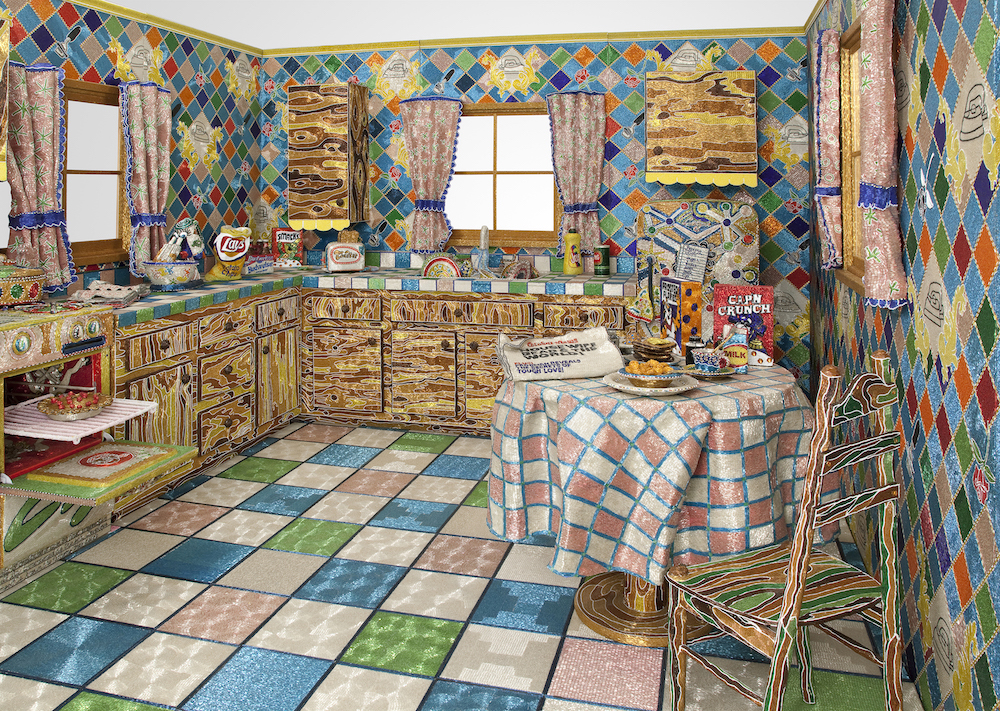 Liza Lou, “Kitchen,” 1991-96, beads, plaster, wood, and found objects, 96 x 132 x 168 inches, Whitney Museum of American Art, New York, photo by Tom Powel © Liza Lou.
Liza Lou, “Kitchen,” 1991-96, beads, plaster, wood, and found objects, 96 x 132 x 168 inches, Whitney Museum of American Art, New York, photo by Tom Powel © Liza Lou.
However, now fully immersed in “quarantimes” and the rising numbers of American cases that nightmarishly suggest an infinite loop of lockdowns, sickness, and death, the work breeds a new feeling. More broadly, Kitchen has become both a prescient reminder of enforced limitation and a curious reflection on quarantine visual culture. We are re-engaging in the cycle that Liza Lou’s artworks observe: the chipping away at an aesthetically familiar system of oppression until a more pervasive, more brutish reality is revealed.
In Kitchen, the checkerboard walls in a diagonal bead-scape of Crayola-bright oranges, reds, blues, and purples, resemble a chain-link fence. The likeness is intensified by Lou’s later representations and reconstructions of such a fence in Security Fence (2005), Conditions of Capture (2006), and the more elaborate Maximum Security (2007-2008). And then there’s the gate-like structure of Barricade (2007-2008) and the tiled walls of Cell (2004-2006), a beaded cell featuring only a swampy floor, a bucket, and a bright, overhead light. Lou’s work, which is simultaneously playful and tragic, deals with different kinds of confinement. She describes spaces where environments become destiny, where national identities inscribe themselves on the environments, then movements, then minds of inhabitants.
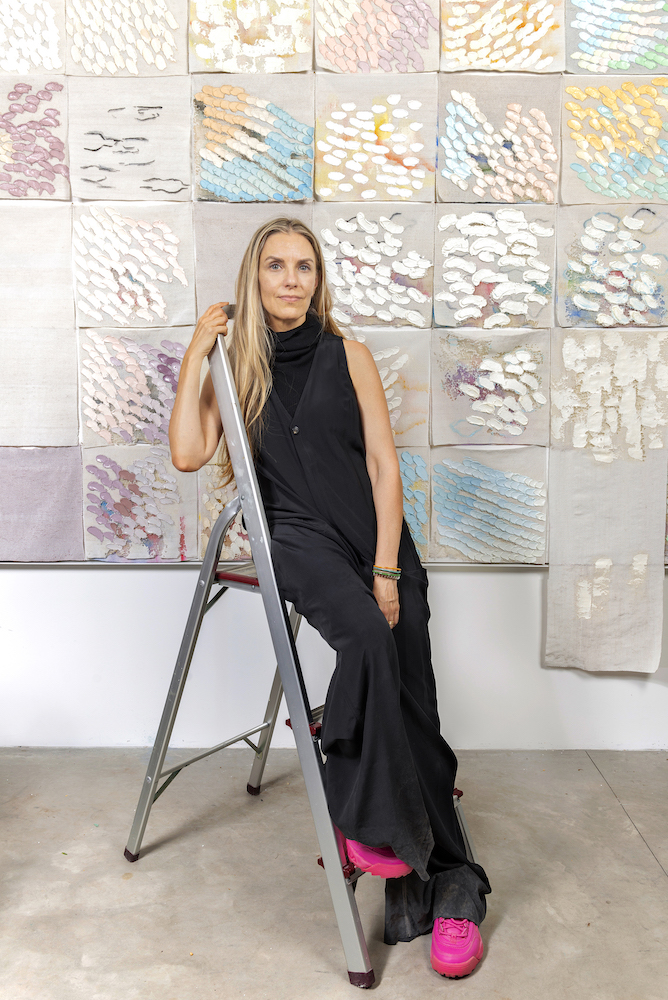 Liza Lou in her studio, 2019, photo by Zihui Song, courtesy the artist and Lehmann Maupin, New York, Hong Kong, and Seoul.
Liza Lou in her studio, 2019, photo by Zihui Song, courtesy the artist and Lehmann Maupin, New York, Hong Kong, and Seoul.
Kitchen limns the prominent psychological state of isolation and the “zany hysteria” that it may induce. As Lou told me over the phone, “It’s a space that I relate to right now more than ever. It was made out of this horror vacui, every single surface is covered and subsumed with intensity. That’s what this moment has very much felt like. Suddenly, millions of people who are lucky enough to have homes are stuck in their homes and in their kitchens. And daily objects take on this enormity that normally we pass through.”
Lou does not exaggerate this intensity; in Kitchen, every object is enclosed in beads, asphyxiated by glass and labor. There are stereotypical, commercial representations of women that are limiting in their own way. The oven brandishes a poem about “the honorable work / Of woman and of wife” by Emily Dickinson, a famously secluded celebrity. The bar-like grates of the oven rack neatly imprison Aunt Jemima, whose image was only retired this year. Cartoonish germs, gesticulating like something out of a high school biology textbook, plaster plates and creep up the curtains, suggesting the manipulation of scientific discourse to restrict women and their bodies. An abandoned cereal bowl implies the presence of children—being socialized into this characterization of domestic labor—and so, feminine labor becomes an inheritance. It’s not just repetitive and narrow; it’s cyclical.
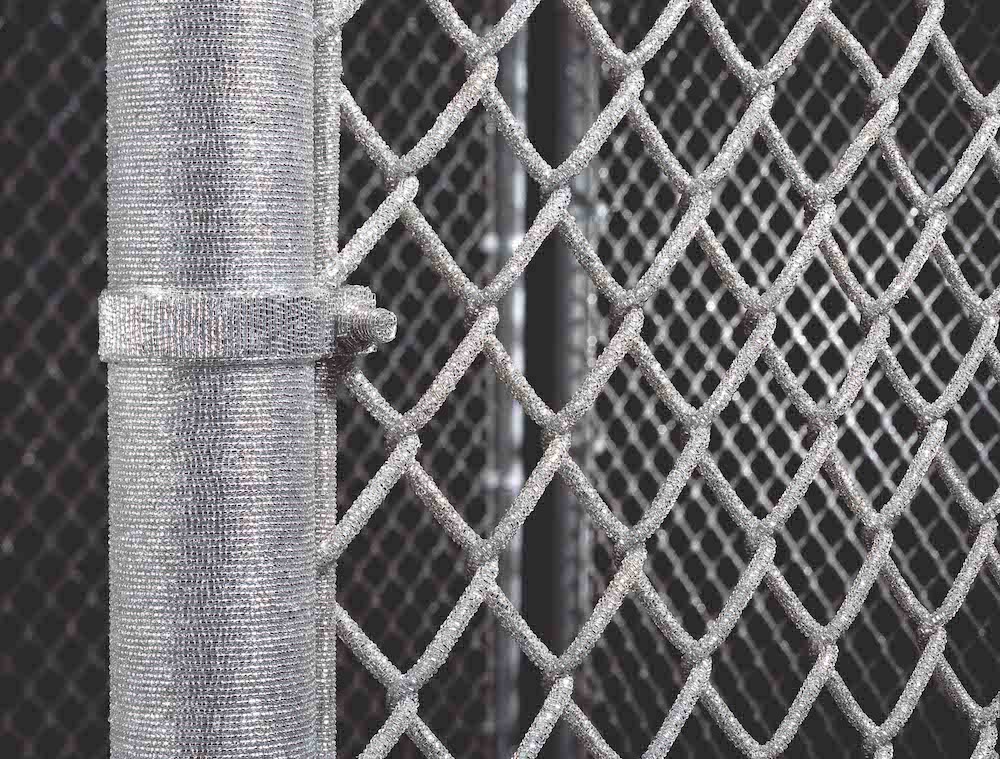 Liza Lou, “Security Fence” (detail), 2005, glass beads on steel and razor wire, 132 x 156 x 156 inches, photo by Tom Powell, courtesy the artist and Lehmann Maupin, New York, Hong Kong, Seoul, and London.
Liza Lou, “Security Fence” (detail), 2005, glass beads on steel and razor wire, 132 x 156 x 156 inches, photo by Tom Powell, courtesy the artist and Lehmann Maupin, New York, Hong Kong, Seoul, and London.
The overall effect, which is so overwhelming as to almost feel imagined—an impossible, tense magic—insists that the rest of the world fall away as your vision confines itself. How drab was your landscape before you entered this effervescent fantasy? Kitchen is, above all, intensely beautiful. You begin to understand what is so enticing, absorbing—and psychologically restrictive—about the American dream.
When Lou created Kitchen, she was in her twenties and thought she was describing something that had passed, “the sexism of the 1950s and 1960s.” And the work leads with empathy for that Historical Woman, confined to the home, taking up household drudgery on her own. If the kitchen is about warmth and industry, it is also a room of loneliness. It is not just about a woman confined, but where a woman does not go because she is confined. It is about drudgery perhaps done with love, it is about a life that is beauty and repulsion, a life that may have been chosen but is not free. It is, in a sense, a physical manifestation of Betty Friedan’s “problem that has no name,” endemic and yet hidden among the denizens of the private sphere.
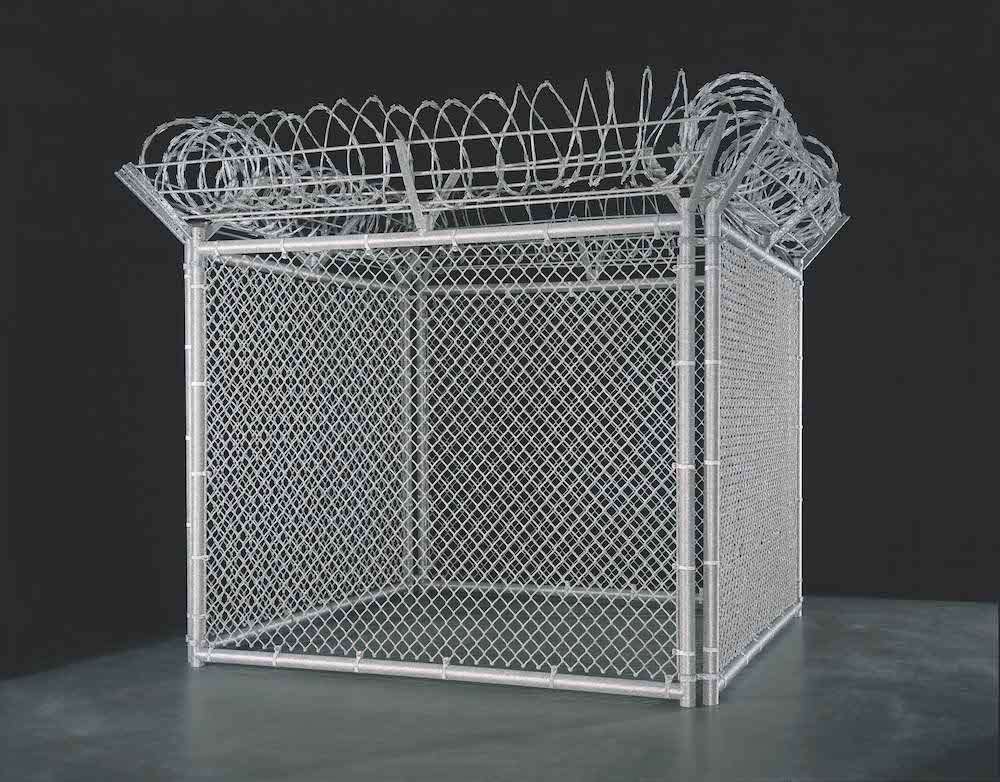 Liza Lou, “Security Fence,” 2005, glass beads on steel and razor wire, 132 x 156 x 156 inches, photo by Tom Powell, courtesy the artist and Lehmann Maupin, New York, Hong Kong, Seoul, and London.
Liza Lou, “Security Fence,” 2005, glass beads on steel and razor wire, 132 x 156 x 156 inches, photo by Tom Powell, courtesy the artist and Lehmann Maupin, New York, Hong Kong, Seoul, and London.
Of course, these ideas resonate now (especially now), as in the past. “I didn’t know the extent to which the struggle continues for women across the board,” Lou added. “I thought I was commenting upon it, but not that I was actually living it.” Even in her use of beads, which were not accepted as a mainstream material by traditional, patriarchal institutions, Lou says she eventually “understood every permutation of insult around that.” She set out to invent a new material language, to apply beads to popular culture, and subvert its “condescending, sexist, racist, pejorative” messages. “Kitchen asks, are we endlessly confined to this? Are we trapped? Can we ever get out from under?”
Kitchen examines how we are taught to be comfortable with the limitations we “choose” in order to uphold society as it is known, but Lou’s subsequent works examine confinement without even the illusion of choice. Security Fence, Maximum Security, and Cell examine not just confinement, but also those “conditions of capture.”
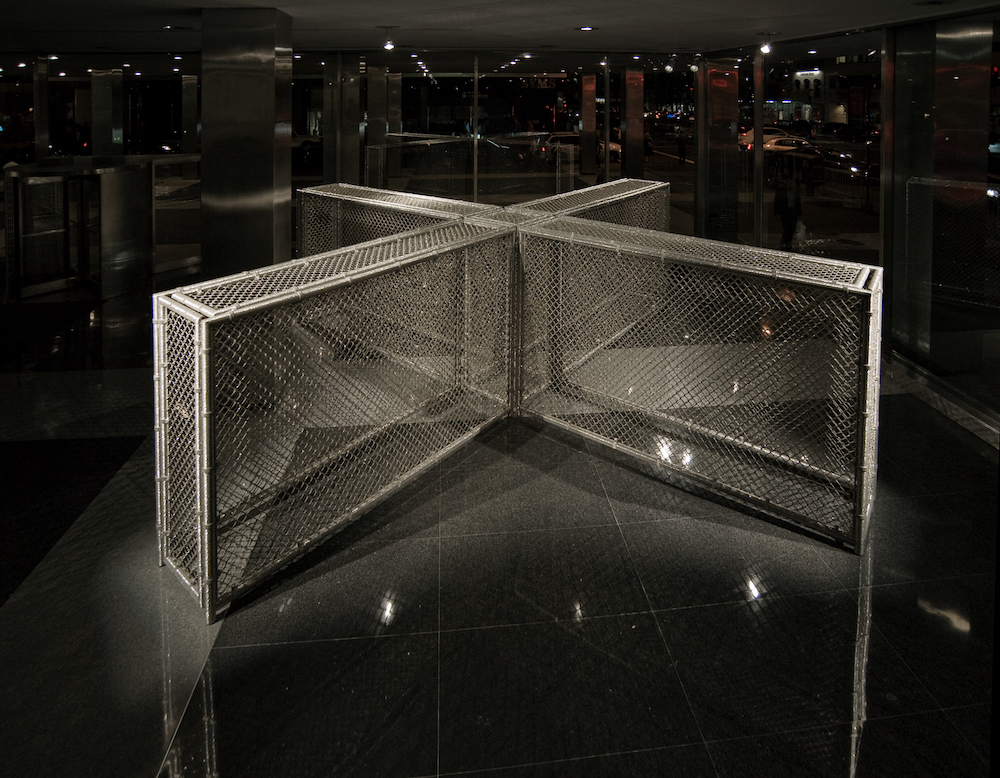 Liza Lou, “Maximum Security,” 2007-2008, glass beads on steel, 276 x 276 x 80 inches, courtesy the artist and Lehmann Maupin, New York, Hong Kong, Seoul, and London.
Liza Lou, “Maximum Security,” 2007-2008, glass beads on steel, 276 x 276 x 80 inches, courtesy the artist and Lehmann Maupin, New York, Hong Kong, Seoul, and London.
Maximum Security, which was crafted by artisans at Lou’s studio in Durban, South Africa over the course of a year, comprises two long chain-link corridors that intersect in the form of an X. The beaded surface glistens. There is no entry or exit. It is a barrier that does not protect. It is designed to prohibit, to limit. The near-endless labor of bead application only aesthetically transforms the global brutality that it represents. These are the chain-links of the school-to-prison-pipeline, of reform schools, of police brutality, even of boarded-up New York department stores, of goods valued over lives.
It is luminous, it is enticing, and it is sparse. And, like Kitchen, it is infinite. As Lou has explained in relation to Maximum Security’s precursor, Security Fence, “I was initially responding to the images of torture and abuse happening in places like Abu Ghraib and Guantánamo Bay. But as an American living and working in South Africa with all of the associations of danger, race issues and post-apartheid, and the incredible amount of barbed wire that’s everywhere, I felt like I was working on a project in exactly the right place and time. All of this was further emphasized by the fact that I made this work with 20 Zulu women, all of whom knew very well the darker meaning of barbed wire fences. During apartheid, the whites surrounded the townships with barbed wire fencing so that they couldn’t get out.”
Security Fence and Maximum Security are works about enclosure, a narrowing-in, where what is beyond is still visible, but beyond reach. As in Kitchen, they are about a world outside that is inaccessible, and these cage-like enclosures are corrals, tools of segregation that do not actually secure those inside. The implied presence of humans, like in many of Lou’s works, disturbingly highlights the lack of human interest and humanity therein. If you can imagine yourself in Kitchen and recognize your childhood cereals, your relationship to the fence is unclear—are you jailor or prisoner? Which side of the fence are you on?
For Lou, her interest in confinement, repetition, and labor are inherently connected to her exploration of the American Dream, as well as fundamental questions about the human condition. “We sort of are trapped in our human selves by birth, you know, by gender, by the color of our skin, where we’re born, brain chemistry, socially, class, sexual orientation. We sort of have this idea as Americans that we can be and do anything. And in fact, we’re very much confined in some ways, to certain aspects of our human selves,” she said. Lou links anecdotal suffering with structural suffering, revealing how political the personal can be.
In an immediate sense, the range of Lou’s work, from the hum of domestic exhaustion to a death-row prison cell, also mirrors the transformation of the visual culture of the pandemic. Instagram initially exploded with frothy coffees, banana breads, and sourdough starters. Zoom screenshots demarcated our separation into distinct squares—like immovable Brady Bunch characters or fixtures in a grid-like abstraction—expressing some desperate desire to connect, as well as our blurred public, private, and professional boundaries. Photographers captured life through windowpanes. Now, petitions, email templates, info-graphics, and records of the brutal policing of those protesting police brutality have replaced these images. Reflections on domestic confinement, inconvenience, and boredom have been exchanged for calls to action.
And, as Lou has, we are recognizing that everything connects under the misplaced trust brokered by the American Dream. As James Baldwin observed in 1962, “We are controlled here by our confusion, far more than we know, and the American dream has therefore become something much more closely resembling a nightmare, on the private, domestic, and international levels.” The nightmare that seemed personal has been clearly exposed as a system of inequalities; the forces of oppression are multi-pronged. And we are perpetually engaged in a cycle of realizing, remembering, exposing, challenging, and forgetting.
When I ask Lou about the progressive nature of her work, how it fits into this culture, she replies, “I really hope with all my heart, every single thing that I’ve made in my life, for it to be work that stands for justice and for beauty.” She asserts, though, that she does not think her work will change anyone’s mind, however implicitly political its bent. “I really feel like we have to be political beings in our private lives. It has to just be part of what we do. Not just talking about it, but going out there and doing the work. And that’s how things will truly get better.”
While Lou doubts her ability to shift perception, I suggest that her work engages an essential level of empathy that may build critical thinking and care (especially in how she reframes the familiar). “I feel as though being an artist is about asking really difficult questions. And when you do that, you’re going to get some difficult answers. So it’s about having the courage to live in a place of uncertainty, with discomfort,” she explained. “All the really important works that I care about–everything from, say, a novel by Virginia Woolf, or David Hammons’s sculpture, In the Hood, challenges and redefines the way we see the world and expands, as you say, our empathy and not to mention our experience of what an artwork can be. The writer, George Saunders, talks about the task of a writer being to make a scale model of the world and basically to see if it’s possible to see it in all of its complexity and love it more. I aspire to that. That’s what I aspire to in my work.”
“Making Knowing: Craft in Art, 1950–2019” will be on view at the Whitney Museum of American Art until February 2022.






